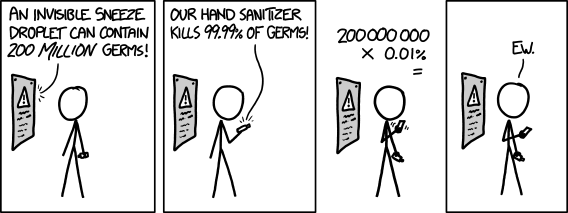Difference between revisions of "1161: Hand Sanitizer"
(general trivia not trivia) |
|||
| Line 19: | Line 19: | ||
:Cueball (typing on calculator): 200 000 000 × 0.01% = | :Cueball (typing on calculator): 200 000 000 × 0.01% = | ||
:Cueball: Ew. | :Cueball: Ew. | ||
| − | |||
| − | |||
| − | |||
{{comic discussion}} | {{comic discussion}} | ||
Revision as of 06:45, 4 September 2014
| Hand Sanitizer |
 Title text: Hipster CDC Reports Flu Epidemic Peaked Years Ago |
Explanation
The number of germs that would be left after using the hand sanitizer is 200 million times 0.01%. 0.01% is equivalent to .0001 decimal, so the simple equation is 200,000,000 × .0001. That equals 20 thousand germs, which is still a surprisingly large number of germs. Recently scientists have shown that it only takes 20 virus particles to infect someone [1] (with analyzed virus; not all germs are equally effective). However, they have also previously noted that the effectiveness of hand sanitizer is actually higher than 99.99%, but it's a bit awkward to print a more precise decimal in an advertising slogan.
"Hipster CDC" is a combination of the acronym for the Centers for Disease Control and Prevention, an organization dedicated to studying infectious diseases and limiting their spread, with the label hipster. Hipsters form a cultural group associated with a distaste for popular culture; they stereotypically talk about how bands, authors, etc. were better before they "went mainstream" and proclaim that they liked a certain thing "before it was cool."
The title text extends this sensibility to the flu, which in fact did peak years ago, such as in 1918, when a world-wide flu epidemic killed tens of millions. The humor lies in the notion that the "Hipster CDC" apparently approves of the time when the flu was more widespread and fatal, while most people consider the diminishment of the flu is a good thing. This could be a jab at hipsters' common insistence on liking things before they "go mainstream": many things, before they go mainstream, just aren't very good, and therefore hipsters' taste in things is highly questionable.
Transcript
- Poster: An invisible sneeze droplet can contain 200 million germs!
- Product label: Our hand sanitizer kills 99.99% of germs!
- Cueball (typing on calculator): 200 000 000 × 0.01% =
- Cueball: Ew.
Discussion
Does anyone think the "peak" referred to in the title text could be the 1918 flu pandemic? Or even the bird flu outbreak?Chexwarrior (talk) 10:31, 16 January 2013 (UTC)
- I'm thinking the "hipster" comment is a reference to how hipsters always think stuff was better (or it peaked) in the past so it must be on the downslide.--Joehammer79 (talk) 14:47, 16 January 2013 (UTC)
That 99.99% number on the hand sanitizer is probably made up anyway. Any actual scientific measure of effectivity would need to take into account different resistance of different types of germs. So, question is, is the sanitizer more or less effective? -- Hkmaly (talk) 10:35, 16 January 2013 (UTC)
- I actually had in the back of my mind that the 99.99% figure wasn't a "dead germ count," but the number of strains of germs the sanitizer has the ability to kill. i.e. there are some strains which it doesn't kill. —98.122.166.235 12:59, 16 January 2013 (UTC)
- Actually 99.99% isn't made up, its actually derived from how accurate the lab tests are. Most antibacterials, even plain 15% alcohol, will kill ALL infectious bacteria and viruses but you cannot confirm this because there are errors inherent in the tests such as contamination from the environment or more often that the samples have to grow (in the case of bacteria) or infect (in the case of viruses) to give a measurable result since you cannot tell by normal observation which are dead and which are live. With the tiny numbers that may survive the likelihood of infection or growth is low, resulting in errors with even the strongest chemical agents. --31.205.24.175 18:56, 16 January 2013 (UTC)
- 15% alcohol is hardly effective (please state source), most effective is 70%, which means anything lower doesn't kill all bacteria. Alcohol is also only partially effective against viruses. It needs other agents to boost its effectivity. 178.197.254.3 09:27, 17 January 2013 (UTC)
Shouldn't 200 million times .01% actually be equivalent to 200 million times .0001, which equals 20 000 germs? 134.169.169.121 13:16, 16 January 2013 (UTC)
Yes, it should. I wonder if he will change it when he notices? 24.93.151.187 13:37, 16 January 2013 (UTC)
Yes, 2 000 000 * .01% = 20 000 is correct
Quite aside from the arithmetic, right now the US has two epidemics: influenza and norovirus, which is often known by the misnomer of "stomach flu." According to infectious disease experts, while alcohol is likely pretty effective against bacteria and SOME viruses including influenza, alcohol is probably NOT very effective against norovirus. The best way to stop the spread of norovirus: frequent hand washing with soap and water. 24.91.233.200 13:47, 16 January 2013 (UTC)
- I'm sure that it will not stop people from trying to use alcohol to get rid of norovirus infection. :-) -- Hkmaly (talk) 11:05, 7 March 2014 (UTC)
"The humor (if a worldwide disaster can be said to be humorous)" I found this funnier than the comic, really. 189.123.133.183 04:17, 21 January 2013 (UTC)
I'm surprised no-one had commented in 2020 :P Wow, I just had a weird thought; I wonder how many of the earlier commenters on here are still alive? Statistically... -- The Cat Lady (talk) 18:40, 22 September 2021 (UTC)